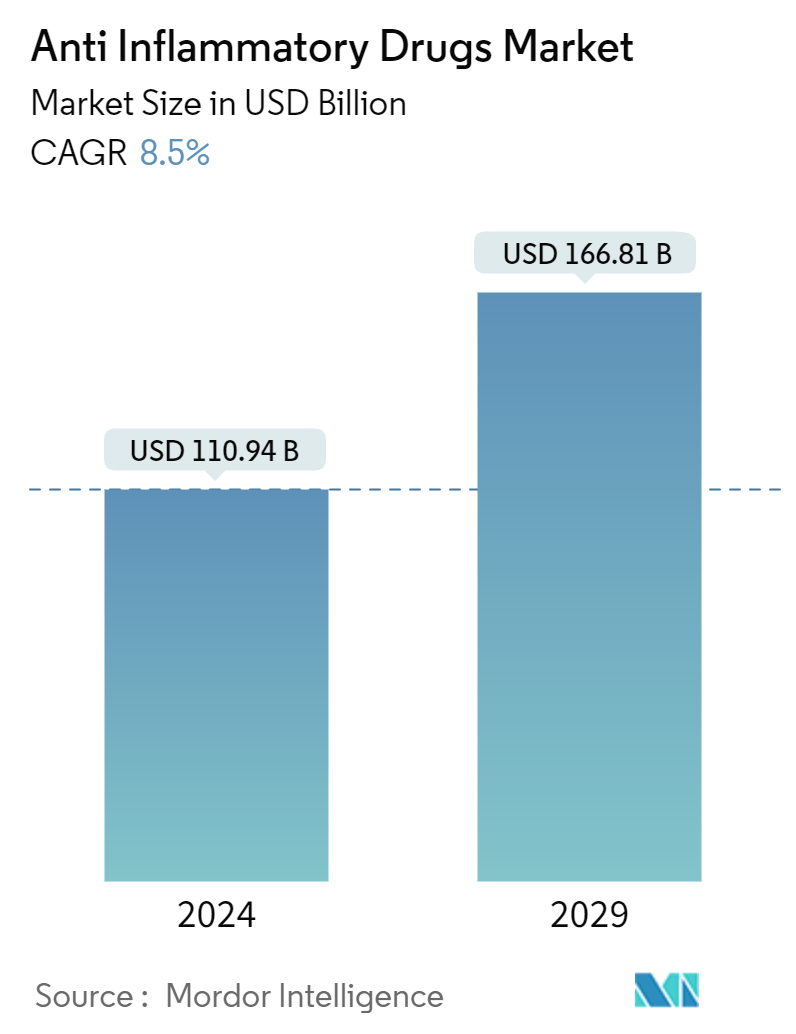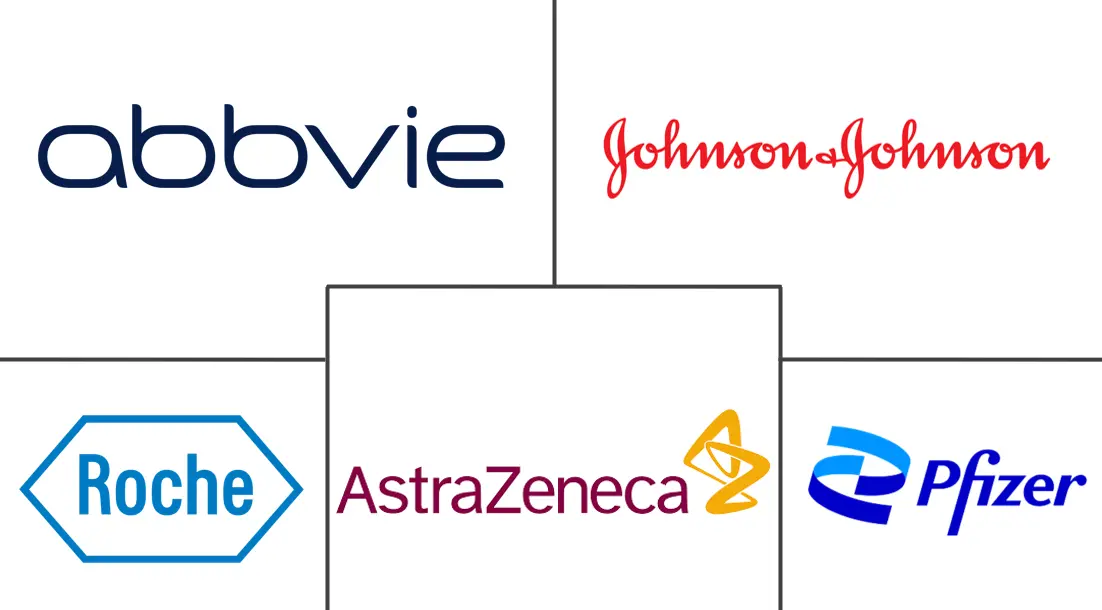Market Size of Anti Inflammatory Drugs Industry

| Study Period | 2019 - 2029 |
| Market Size (2024) | USD 110.94 Billion |
| Market Size (2029) | USD 166.81 Billion |
| CAGR (2024 - 2029) | 8.50 % |
| Fastest Growing Market | Asia Pacific |
| Largest Market | North America |
Major Players
*Disclaimer: Major Players sorted in no particular order |
Need a report that reflects how COVID-19 has impacted this market and its growth?
Anti Inflammatory Drugs Market Analysis
The Anti Inflammatory Drugs Market size is estimated at USD 110.94 billion in 2024, and is expected to reach USD 166.81 billion by 2029, growing at a CAGR of 8.5% during the forecast period (2024-2029).
The anti-inflammatory drugs market is poised for substantial growth, driven by rising incidences of autoimmune, inflammatory, and respiratory conditions and growing research for safer new anti-inflammatory drugs. Conditions like arthritis, allergies, and chronic inflammatory diseases are on the rise, driven by factors such as aging populations and lifestyle changes. Hence, the need for anti-inflammatory drug treatments is expected to increase, boosting the market’s growth over the forecast period.
There are alarming health disparities linked to chronic inflammation, particularly among vulnerable populations. For instance, in January 2024, a study spearheaded by a researcher from the University of Florida’s College of Public Health and Health Professions revealed that individuals grappling with chronic inflammation and living in poverty face a two-fold increased risk of succumbing to heart diseases and an almost three-fold heightened risk of cancer within the subsequent 15 years. Similarly, in 2023, a study spearheaded by Mainous showed 34.6% of US adults exhibiting signs of systemic inflammation. This shows the risk of inflammation and the need for proper treatment, which is expected to drive the market’s growth over the forecast period.
The growing accessibility of anti-inflammatory medications, driven by new product approvals and strategic partnerships aimed at developing innovative therapies, is anticipated to enhance market growth in the coming years. For example, in February 2024, AbbVie Inc. and OSE Immunotherapeutics SA established a strategic collaboration to further the development of OSE-230, a monoclonal antibody targeting chronic and severe inflammation, which was in the pre-clinical stage. This kind of trend is likely to expand the product offerings, contributing positively to market growth during the forecast period.
Therefore, the growing burden of inflammatory conditions and continuous innovations in anti-inflammatory drugs are expected to drive market growth globally. However, the side effects related to anti-inflammatory drugs and patent expiration of various branded drugs are expected to restrain market growth over the forecast period.
Anti Inflammatory Drugs Industry Segmentation
As per the scope of the report, anti-inflammatory drugs are medications that reduce inflammation, which is the body’s natural response to injury or infection. These drugs are used to treat various conditions characterized by inflammation, including arthritis, asthma, inflammatory bowel disease, and other autoimmune disorders.
The anti-inflammatory drugs market is segmented by treatment, drug class, sales channel, and geography. By treatment, the market is segmented into arthritis, chronic obstructive pulmonary disease (COPD), multiple sclerosis, inflammatory bowel disease (IBD), asthma, tendonitis, and other treatments. By drug class, the market is segmented into anti-inflammatory biologics, non-steroidal anti-inflammatory drugs (NSAIDs), corticosteroids, immune-selective anti-inflammatory derivatives (ImSAID), and other drug classes. By sales channel, the market is segmented into prescription and over-the-counter (OTC). By geography, the market is segmented into North America, Europe, Asia-Pacific, Middle East and Africa, and South America. The report also covers the estimated market sizes and trends for 17 countries across major regions globally. The report offers the value (USD) for all the above segments.
| By Treatment | |
| Arthritis | |
| Chronic Obstructive Pulmonary Disease (COPD) | |
| Multiple Sclerosis | |
| Inflammatory Bowel Disease (IBD) | |
| Asthma | |
| Tendonitis | |
| Other Treatments |
| By Drug Class | |
| Anti-Inflammatory Biologics | |
| Non-steroidal Anti Inflammatory Drugs (NSAIDS) | |
| Corticosteroids | |
| Immune-selective Anti-inflammatory Derivative (ImSAID) | |
| Other Drug Classes |
| By Sales Channel | |
| Prescription | |
| Over the Counter (OTC) |
| Geography | ||||||||
| ||||||||
| ||||||||
| ||||||||
| ||||||||
|
Anti Inflammatory Drugs Market Size Summary
The anti-inflammatory drugs market is experiencing significant growth, driven by the increasing prevalence of conditions such as asthma, arthritis, and chronic obstructive pulmonary disease (COPD). Despite challenges like side effects and the expiration of patents for blockbuster drugs, advancements in research, particularly in anti-inflammatory biologics and immune selective anti-inflammatory derivatives, are helping to mitigate these issues. This progress is crucial in maintaining the efficacy and potency of these drugs while reducing side effects. Additionally, heightened awareness of anti-inflammatory therapeutics and supportive government initiatives are further propelling market expansion. The prevalence of arthritis, especially among the geriatric population, is contributing to the demand for these drugs, with non-steroidal anti-inflammatory drugs (NSAIDs) and newer biologics being commonly prescribed despite potential side effects.
Regionally, North America holds the largest share of the anti-inflammatory drugs market, supported by a robust healthcare sector, substantial investments, and a demand for safer and more effective treatments. The region benefits from high per capita income, frequent patient visits to healthcare providers, and significant research funding. Conversely, the Asia Pacific region is poised to be the fastest-growing market, fueled by a large patient base, increasing disposable incomes, and rising healthcare expenditure. The market is predominantly led by global key players such as Amgen Inc, Sun Pharmaceutical Industries Ltd, Johnson & Johnson, Pfizer Inc., and Novartis AG, who leverage their financial resources for research and have established strong distribution networks.
Anti Inflammatory Drugs Market Size - Table of Contents
-
1. MARKET DYNAMICS
-
1.1 Market Overview
-
1.2 Market Drivers
-
1.2.1 Rising Incidences of Autoimmnue and Respiratory Conditions
-
1.2.2 Growing Research for Safer New Anti-Inflammatory Drugs
-
-
1.3 Market Restraints
-
1.3.1 Side Effects of Anti-Inflammtory Drugs
-
1.3.2 Patent Expiration
-
-
1.4 Porter's Five Force Analysis
-
1.4.1 Threat of New Entrants
-
1.4.2 Bargaining Power of Buyers/Consumers
-
1.4.3 Bargaining Power of Suppliers
-
1.4.4 Threat of Substitute Products
-
1.4.5 Intensity of Competitive Rivalry
-
-
-
2. MARKET SEGMENTATION (Market Size by Value - USD)
-
2.1 By Treatment
-
2.1.1 Arthritis
-
2.1.2 Chronic Obstructive Pulmonary Disease (COPD)
-
2.1.3 Multiple Sclerosis
-
2.1.4 Inflammatory Bowel Disease (IBD)
-
2.1.5 Asthma
-
2.1.6 Tendonitis
-
2.1.7 Other Treatments
-
-
2.2 By Drug Class
-
2.2.1 Anti-Inflammatory Biologics
-
2.2.2 Non-steroidal Anti Inflammatory Drugs (NSAIDS)
-
2.2.3 Corticosteroids
-
2.2.4 Immune-selective Anti-inflammatory Derivative (ImSAID)
-
2.2.5 Other Drug Classes
-
-
2.3 By Sales Channel
-
2.3.1 Prescription
-
2.3.2 Over the Counter (OTC)
-
-
2.4 Geography
-
2.4.1 North America
-
2.4.1.1 United States
-
2.4.1.2 Canada
-
2.4.1.3 Mexico
-
-
2.4.2 Europe
-
2.4.2.1 Germany
-
2.4.2.2 United Kingdom
-
2.4.2.3 France
-
2.4.2.4 Italy
-
2.4.2.5 Spain
-
2.4.2.6 Rest of Europe
-
-
2.4.3 Asia-Pacific
-
2.4.3.1 China
-
2.4.3.2 Japan
-
2.4.3.3 India
-
2.4.3.4 Australia
-
2.4.3.5 South Korea
-
2.4.3.6 Rest of Asia-Pacific
-
-
2.4.4 Middle East and Africa
-
2.4.4.1 GCC
-
2.4.4.2 South Africa
-
2.4.4.3 Rest of Middle East and Africa
-
-
2.4.5 South America
-
2.4.5.1 Brazil
-
2.4.5.2 Argentina
-
2.4.5.3 Rest of South America
-
-
-
Anti Inflammatory Drugs Market Size FAQs
How big is the Anti Inflammatory Drugs Market?
The Anti Inflammatory Drugs Market size is expected to reach USD 110.94 billion in 2024 and grow at a CAGR of 8.5% to reach USD 166.81 billion by 2029.
What is the current Anti Inflammatory Drugs Market size?
In 2024, the Anti Inflammatory Drugs Market size is expected to reach USD 110.94 billion.

